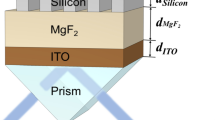Abstract
This work proposes and investigates theoretically a biosensor that is an integrated plasmonic Mach–Zehnder interferometer. The biosensor consists of three sections. The first and third sections are input and output dielectric waveguides whose core is a silicon film. The second section is a combination of a surface plasmon polariton waveguide and a metal-insulator-silicon waveguide, which are separated by a thick gold film. The former and the latter function as sensing and reference arms, respectively. The latter supports a mode whose fields are highly enhanced in a thin insulator, silicon nitride film, and it has relatively small propagation loss. It is shown that the biosensor has insertion loss lower than 2 dB, and that it is very compact since the length of its second section for sensing is shorter than 6 μm. In addition, it is discussed that it can be easily implemented by using simple fabrication processes. Analyzed are the characteristics of sensing a refractive index change of liquid covering the biosensor. Despite its compactness, they are similar to those of previous surface plasmon interferometers. Also, its characteristics as a DNA sensor are analyzed. The analysis demonstrates that the biosensor can detect sensitively target single-stranded DNAs whose total weight is smaller than 10 fg.









Similar content being viewed by others
References
Homola J, Yee SS, Gauglitz G (1999) Surface plasmon resonance sensors: review. Sens Actuators B 54:3–15
Shankaran DR, Gobi KV, Miura N (2007) Recent advancements in surface plasmon resonance immunosensors for detection of small molecules of biomedical, food and environment interest. Sens Actuators B 121:158–177
Schasfoort RBM, McWhirter A (2008) In Schasfoort RBM, Tudos AJ (Ed) SPR Instrumentation, RSC, Cambridge, pp 35–80
Hoa XD, Kirk AG, Tabrizian M (2007) Towards integrated and sensitive surface plasmon resonance biosensors: a review of recent progress. Biosens Bioelectron 23:151–160
Ctyroky J et al (1999) Theory and modeling of optical waveguide sensors utilizing surface plasmon resonance. Sens Actuators B 54:66–73
Dostalek J et al (2001) Surface plasmon resonance biosensor based on integrated optical waveguide. Sens Actuators B 76:8–12
Chu Y-S et al (2006) Surface plasmon resonance sensors using silica-on-silicon optical waveguides. Microwave Opt Technol Lett 48(5):955–957
Charbonneau R et al (2008) Demonstration of surface sensing using long-range surface plasmon waveguides on silica. Sens Actuators B 134:455–461
Joo YH, Song SH, Magnusson R (2009) Long-range surface plasmon-polariton waveguide sensors with a Bragg grating in the asymmetric double-electrode structure. Opt Express 17:10606–10611
Debackere P et al (2006) Surface plasmon interferometer in silicon-on-insulator: novel concept for an integrated biosensor. Opt Express 14:7063–7072
Debackere P, Baets R, Bienstman P (2009) Bulk sensing experiments using a surface-plasmon interferometer. Opt Lett 34(18):2858–2860
SU-8 is the name of the negative photoresists produced by MicroChem Corp. (http://www.microchem.com/products/su_eight.htm), whose refractive index is assumed to be 1.57 in this paper
Feng N-N, Negro LD (2007) Plasmon mode transformation in modulated-index metal-dielectric slot waveguides, Opt Lett 32(21):3086–3088
Oulton RF et al (2008) A hybrid plasmonic waveguide for subwavelength confinement and long-range propagation. Nature Photon 2:496–500
Dai D, He S (2009) A silicon-based hybrid plasmonic waveguide with a metal cap for a nano-scale light confinement, Opt Express 17:16646–16653
Avrutsky I, Soref R, Buchwald W (2010) Sub-wavelength plasmonic modes in a conductor-gap-dielectric system with a nanoscale gap. Opt Express 18:348–363
Kwon M-S (2009) A numerically stable analysis method for complex multilayer waveguides based on modified transfer-matrix equations. J Lightwave Technol 27(20):4407–4414
Rodrigo SG, Garcia-Vidal FJ, Martin-Moreno L (2008) Influence of material properties on extraordinary optical transmission through hole arrays. Phys Rev B 77:075401
Snyder AW, Love JD (1983) Optical waveguide theory, Kluwer Academic pp 212–214
Gaal SB, Hoekstra HJWM, Lambeck PV (2003) Determining PML modes in 2-D stratified media. J Lightwave Technol 21(1):293–298
Mandal S, Erickson D (2008) Nanoscale optofluidic sensor arrays. Opt Express 16:1623–1631
Elhadj S, Singh G, Saraf RF (2004) Optical properties of an immobilized DNA monolayer from 255 to 700 nm. Langmuir 20:5539–5543
Acknowledgment
This work was supported by National Research Foundation of Korea Grant funded by the Korean Government (KRF-2008-313-D00725).
Author information
Authors and Affiliations
Corresponding author
Rights and permissions
About this article
Cite this article
Kwon, MS. Theoretical Investigation of an Interferometer-type Plasmonic Biosensor Using a Metal-insulator-silicon Waveguide. Plasmonics 5, 347–354 (2010). https://doi.org/10.1007/s11468-010-9149-4
Received:
Accepted:
Published:
Issue Date:
DOI: https://doi.org/10.1007/s11468-010-9149-4




